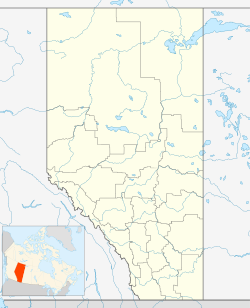Grande Prairie
| Grande Prairie | |||
|---|---|---|---|
| City | |||
| City of Grande Prairie | |||

100 Street, looking south from 100 Avenue
|
|||
|
|||
| Nickname(s): Swan City | |||
| Location of Grande Prairie in Alberta | |||
| Coordinates: 55°10′15″N 118°47′41″W / 55.17083°N 118.79472°WCoordinates: 55°10′15″N 118°47′41″W / 55.17083°N 118.79472°W | |||
| Country | Canada | ||
| Province | Alberta | ||
| Region | Northern Alberta | ||
| Census division | 19 | ||
| Incorporated | |||
| • Village | April 30, 1914 | ||
| • Town | March 15, 1919 | ||
| • City | January 1, 1958 | ||
| Government | |||
| • Mayor | Bill Given | ||
| • Governing body |
Grande Prairie City Council
|
||
| • City Manager | Robert M. Nicolay | ||
| • MP | Chris Warkentin (Conservative) | ||
| • MLA | Wayne Drysdale (Progressive Conservative), Todd Loewen (Wildrose) | ||
| Area (2016) | |||
| • Land | 132.73 km2 (51.25 sq mi) | ||
| Elevation | 650 m (2,130 ft) | ||
| Population (2016) | |||
| • Total | 63,166 | ||
| • Density | 475.9/km2 (1,233/sq mi) | ||
| • Municipal census (2015) | 68,556 | ||
| Time zone | MST (UTC−7) | ||
| • Summer (DST) | MDT (UTC−6) | ||
| Postal code span | T8V to T8X | ||
| Area code(s) | +1-780, +1-587 | ||
| Highways |
Highway 43 Highway 40 |
||
| Waterways | Wapiti River Bear River (Bear Creek) | ||
| Website | Official website | ||
Grande Prairie is a city in northwest Alberta, Canada within the southern portion of an area known as Peace River Country. It is located at the intersection of Highway 43 (part of the CANAMEX Corridor) and Highway 40 (the Bighorn Highway), approximately 456 km (283 mi) northwest of Edmonton. The city is surrounded by the County of Grande Prairie No. 1.
Grande Prairie was the seventh-largest city in Alberta in 2016 with a population of 63,166, and was one of Canada's fastest growing cities between 2001 and 2006.
The city adopted the trumpeter swan as an official symbol due to its proximity to the migration route and summer nesting grounds of this bird. For that reason, Grande Prairie is sometimes nicknamed the "Swan City". The dinosaur has emerged as an unofficial symbol of the city due to paleontology discoveries in the areas north and west of the Grande Prairie.
Grande Prairie was named for the large prairie which lies to the north, east, and west of it. In the 18th century, the prairie was occupied by bands of the Dane-zaa (Beaver) peoples, who began trading with the North West Company at Dunvegan in the early 19th century. The earliest recorded reference to the prairie was by trader Samuel Black in 1824. In 1880, a Hudson's Bay Company post called La Grande Prairie was established by George Kennedy 15 miles (24 km) northwest of the present city. In the late 19th century, the prairie was settled by Cree and Iroquois from around Jasper and Lac Ste. Anne. When 17 townships were surveyed for homesteading in 1909, a land rush soon followed, with many settlers arriving over the Edson Trail. In 1910, the Grande Prairie Townsite was sub-divided. By 1912, it included a bank, hotel, post office, and land office, making it a district metropolis. In 1916, it became the terminus of the Edmonton, Dunvegan and British Columbia Railway from Edmonton.
...
Wikipedia



